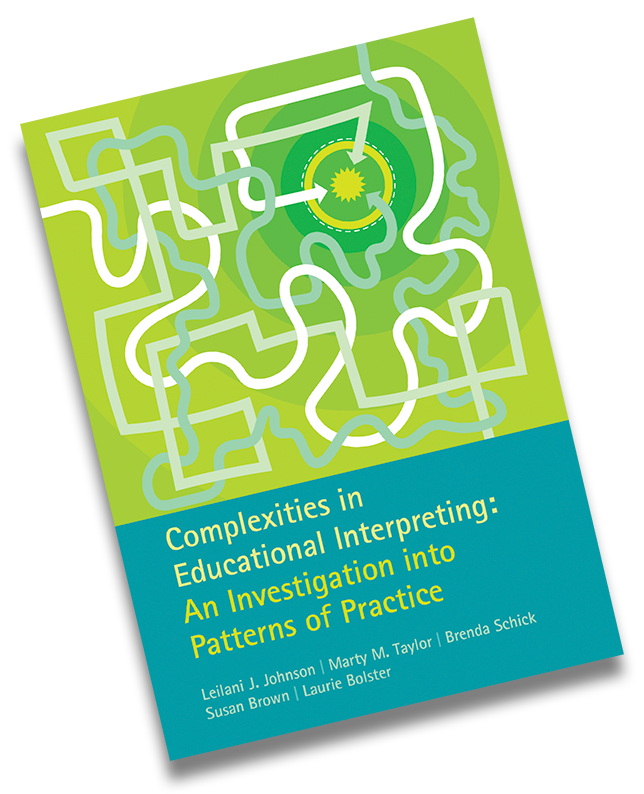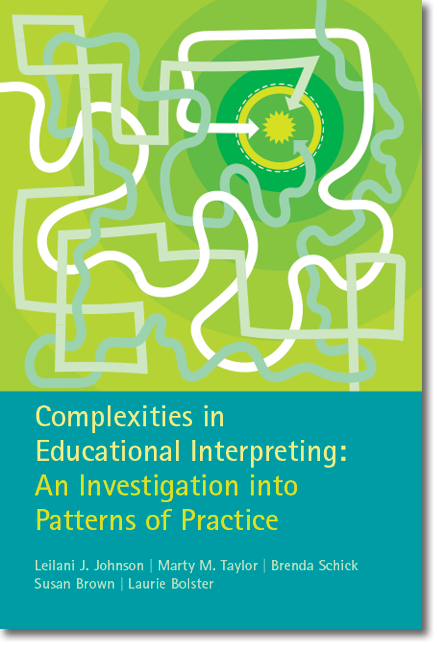
Recently our book Complexities in Educational Interpreting: An Investigation into Patterns of Practice was reviewed in the Journal of Deaf Studies and Deaf Education. Here is the social media review:
By far the most comprehensive resource on educational interpreting, Complexities in Educational Interpreting: An Investigation into Patterns of Practice is a must-read. Dr. Johnson and this expert team of researchers provide a thorough accounting of the complicated journey of the establishment and development of the educational interpreting field. Interpreting practitioners and students, interpreter educators, parents of deaf and hard-of-hearing students of all ages, administrators, researchers, and policy makers will find the information in this book enlightening. The authors provide a compelling case that to meet the needs of deaf and hard-of-hearing students in mainstream school programs, there is a critical and immediate need to ensure that structures be in place so that educational interpreters meet standards of practice as related service providers in accordance with federal legislation.
This book is the most comprehensive and data-driven discussion of current standards and practice of educational interpreters to date. The authors present the findings of a series of investigations designed to identify what interpreters do and what they “could and should contribute to the educational team (p. 1)” as related services personnel. A thorough review of literature published between 2000 and 2013, an extensive exploration of existing state employment standards, and an examination of published curricula for educational interpreters provide a well-rounded discussion of the current context of educational interpreting. In addition, the authors report the findings of a large-scale national survey of educational interpreters, as well as the results of an in-depth analysis of data revealing trends from the Educational Interpreting Performance Assessment (EIPA). Great care was taken to validate the findings of all investigations through interactions with participants at a National Summit on Educational Interpreting, at a meeting of the Deaf Education Consultants of State Educational Agencies (DECSEA), and in interviews with Office of Special Education Programs (OSEP) Scholars.
Chapter One provides an overview of the purpose and structure of the investigations that led to findings that were reported throughout the book. Chapters Two through Four provide a review of federal legislation affecting K-12 interpreters, the literature relevant to the current state of K-12 educational interpreting, and state employment standards. Chapter Five provides an in-depth statistical analysis of the EIPA written and performance tests. Chapters Six and Seven report the results of a national survey and trends identified during a national summit for educational interpreters. Chapters Eight and Nine present the perspectives of the DECSEA and the perspectives of educational interpreting students and graduates of an OSEP supported BA program.
Chapter Ten begins with the striking and disheartening observation that, for decades, there has been a clearly documented need for the improvement of educational interpreting services and a plethora of data substantiating a crisis in meeting the needs of students who are Deaf and hard of hearing in school settings. Furthermore, findings from the multifaceted investigations reported in this book culminate in recommendations that substantiate and reiterate the largely ignored recommendations published in 1989 by the National Task Force on Educational Interpreting. In spite of an egregious lack of forward progress, the authors note that the Supreme Court’s unanimous 2017 Endrew F. ruling, as well as other national actions and efforts, bring with them cause for optimism.
Throughout the book, great care has been taken to provide an extensive overview of available data and to report the findings of investigations regarding current patterns of practice in educational interpreting. The authors provide a compelling argument that upholding current federal legislation recognizing educational interpreters as related services personnel (IDEA, 2004) would go a long way toward creating positive change.
This book is a must-read for any stakeholder interested in improving the practice and profession of educational interpreters.
Johnson, L. J., Taylor, M. M., Schick, B., Brown, S., & Bolster, L. (2018). Complexities in Educational Interpreting: An Investigation into Patterns of Practice. Edmonton, Alberta: Interpreting Consolidated. Paperback. 201 pages. $29.95.
Review by: Melissa B. Smith
The Journal of Deaf Studies and Deaf Education, Volume 25, Issue 3, July 2020, Page 380, https://doi.org/10.1093/deafed/enz054

